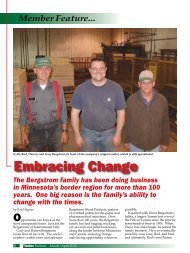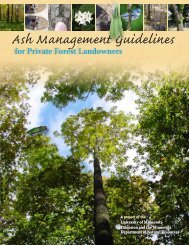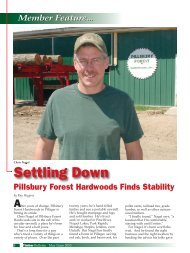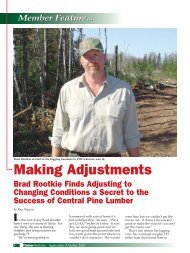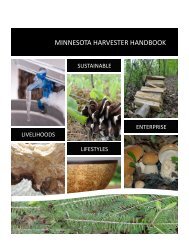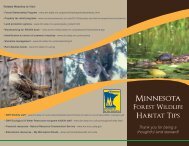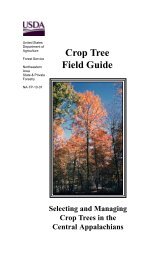Ash Management Guide for Private Forest Landowners
Ash Management Guide for Private Forest Landowners
Ash Management Guide for Private Forest Landowners
You also want an ePaper? Increase the reach of your titles
YUMPU automatically turns print PDFs into web optimized ePapers that Google loves.
Chapter 5The Native PlantCommunitiesFloodplain<strong>Forest</strong> SystemVines:• Wild grapes• Virginia creeper• Canada moonseedHerbaceous plants:• Ostrich fern• Wood nettle• Stinging nettle• Tall coneflower• Honewort• Jewel weed• Carrion-flower• Sweet-scented bedstraw• Side-flowering aster• Ontario aster• Kidney-leaved buttercupGrasses:• Rice cut grass (native)• Virginia wildrye (native)• Reed canary grass (invasive)Terrace and floodplain <strong>for</strong>ests inparticular are not especially diversecommunities. On average, 33 species ofplants are found in 400m 2 . Because ofthe abundance of moist mineral soil, asignificant portion of the flora consistsof germinating plants – many of whichwill not survive <strong>for</strong> long. Thus, the averagenumber of persistent plants is ratherlow, the lowest of any system with ashtrees.Some rare plants and animals aredependent upon floodplain and terrace<strong>for</strong>est habitat in Minnesota.Photo: Fred HarrisWater & Wood: Good & BadRiparian <strong>for</strong>ests provide a long corridor<strong>for</strong> animal habitat and migration.Natural EAB movement will be easiestalong riparian corridors, effectively spreadingit locally at 2-4 miles per year. Riparian<strong>for</strong>ests are important because theyprovide shade to cool streams and normalamounts of fallen trees <strong>for</strong> wood habitatin the water. This is especially importantin sand-bedded streams that lack cobbleand gravel sites <strong>for</strong> spawning, rearing, andinvertebrate attachment. These corridorsalso provide overhead cover.Wood in rivers is a good thing; however,too much wood can cause silt andfine sand to cover spawning and rearingWood jams occur approximatelyevery 300-400 feeton the Rat Root River innorthern Minnesota.Opposite page: Floodplain<strong>Forest</strong> standPhoto: Sandy Verry40



